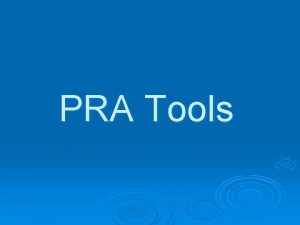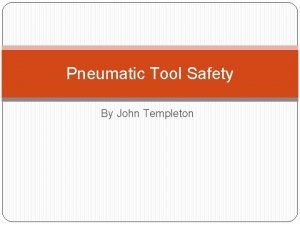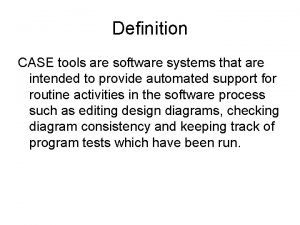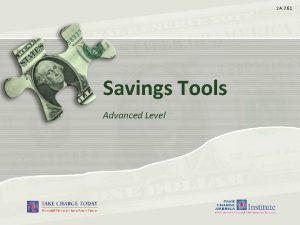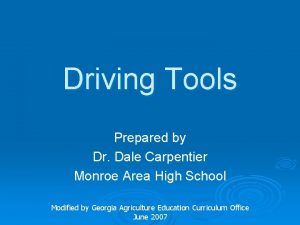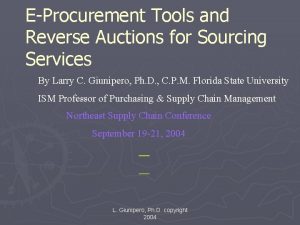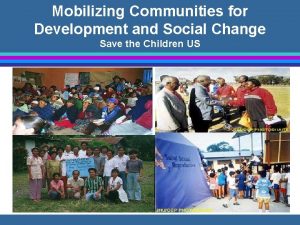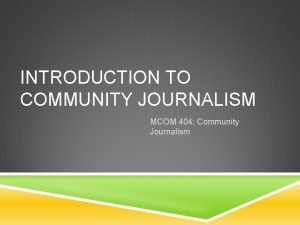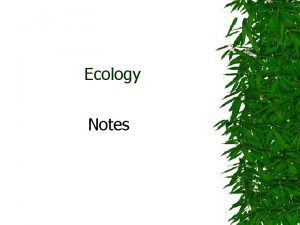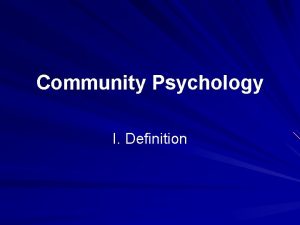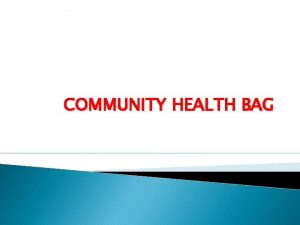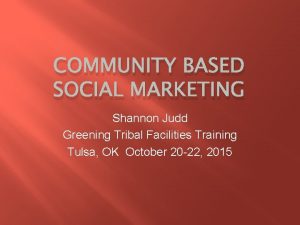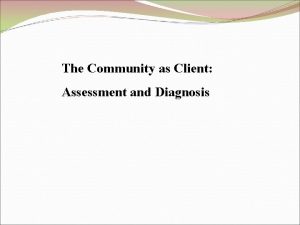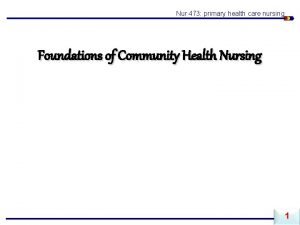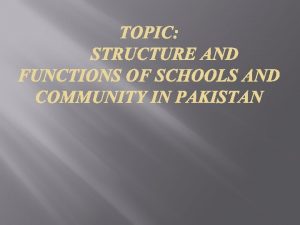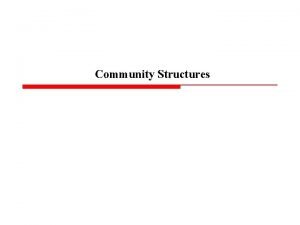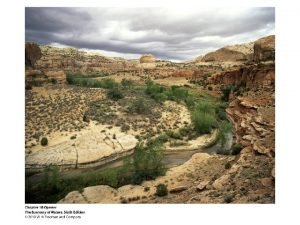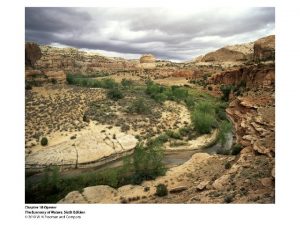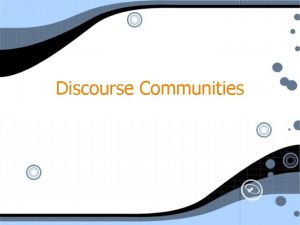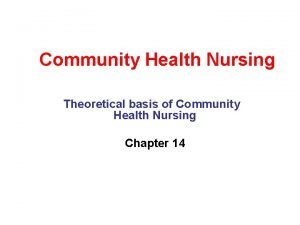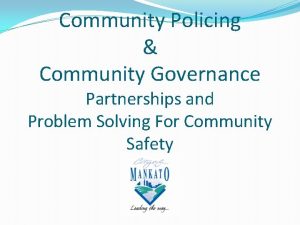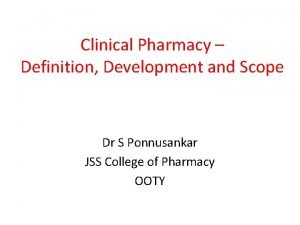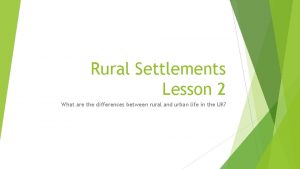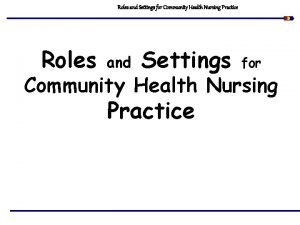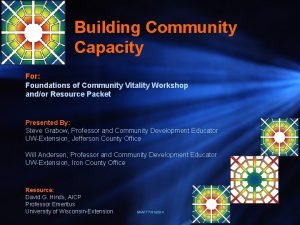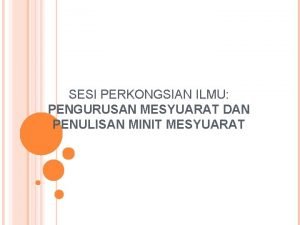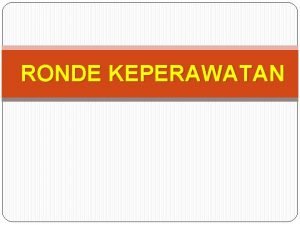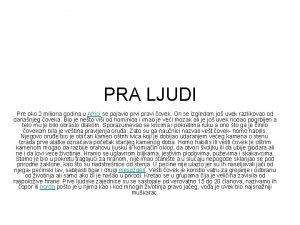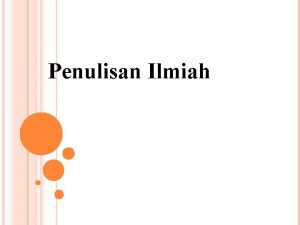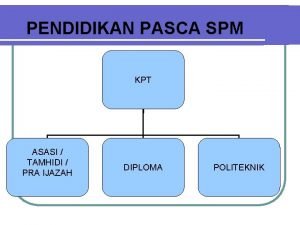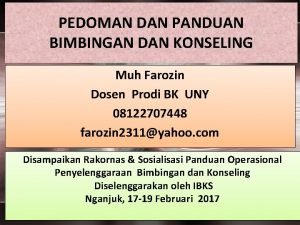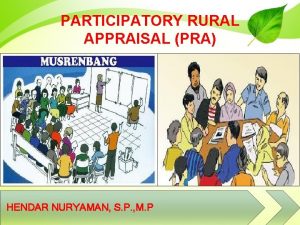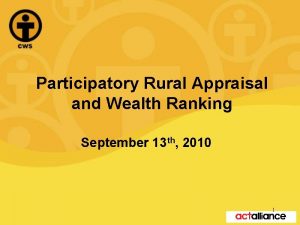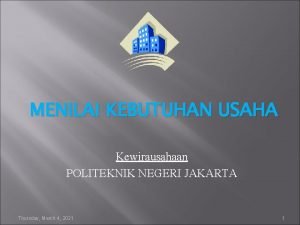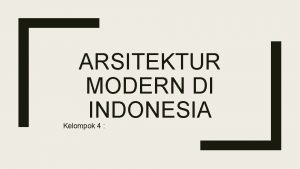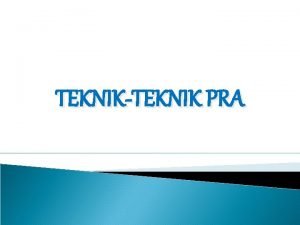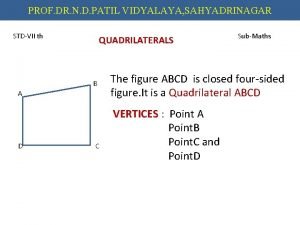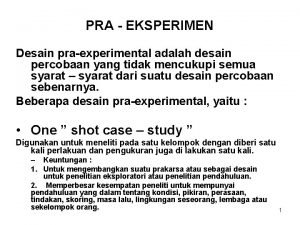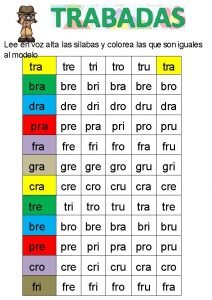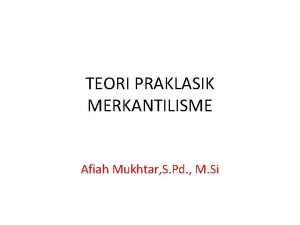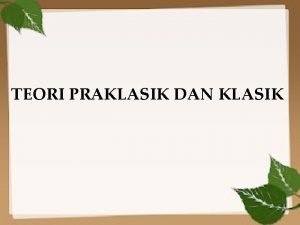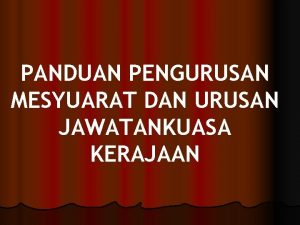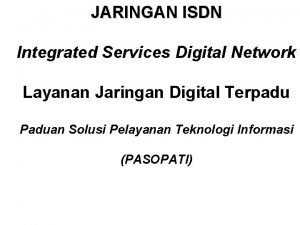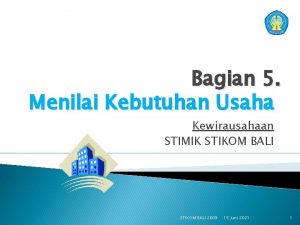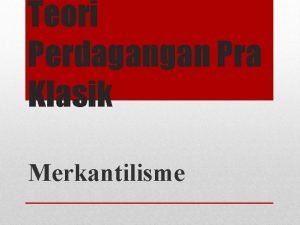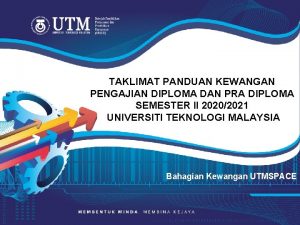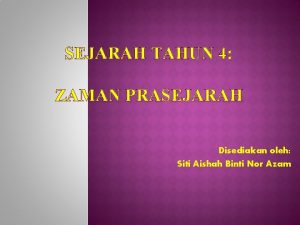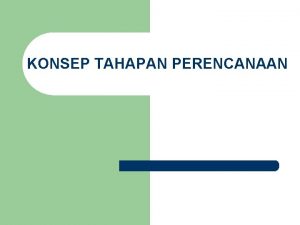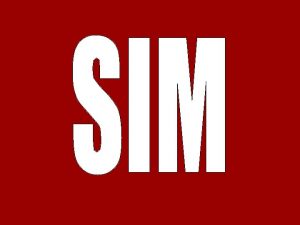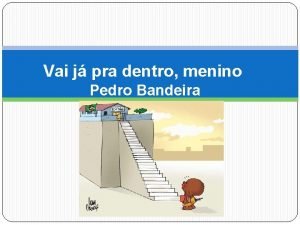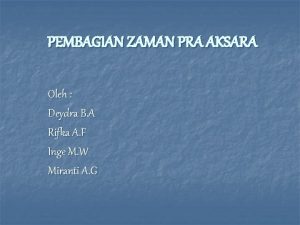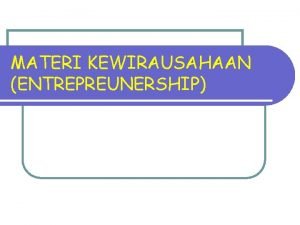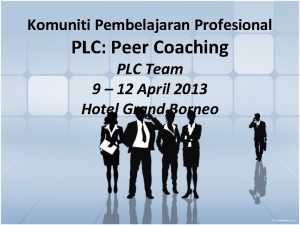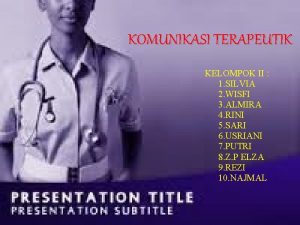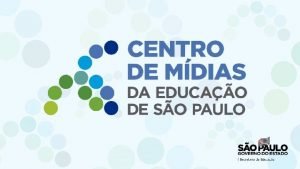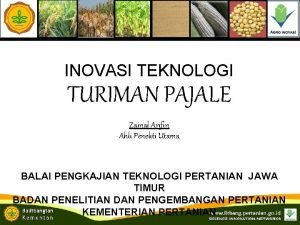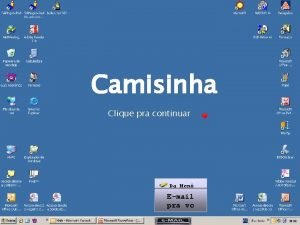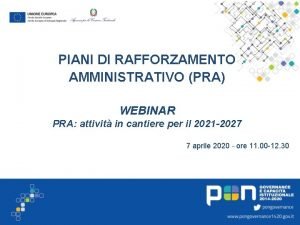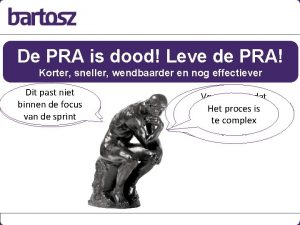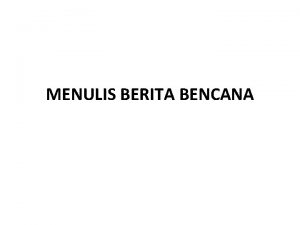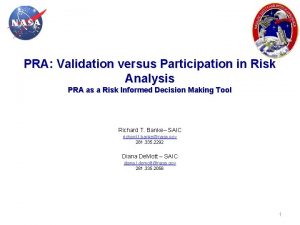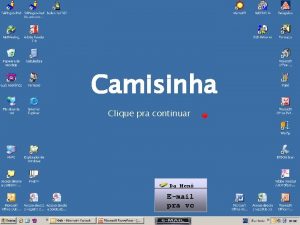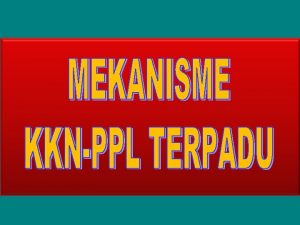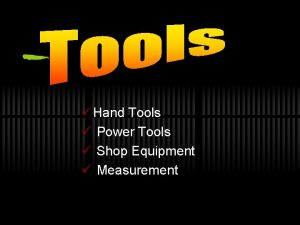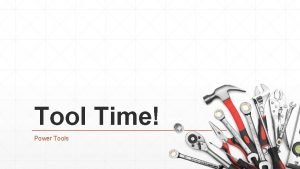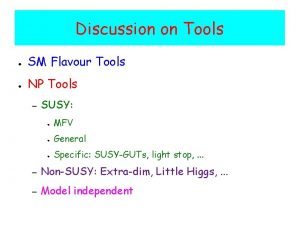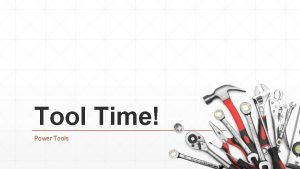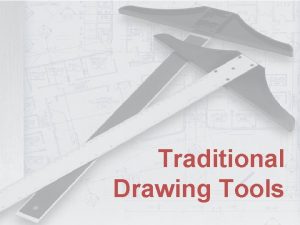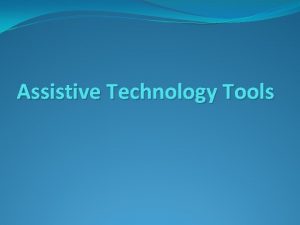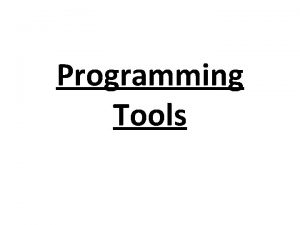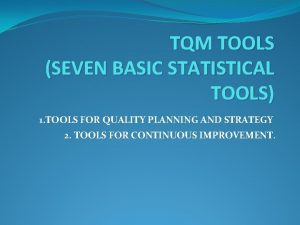PRA Tools PRA definition PRA is a community





























































































- Slides: 93

PRA Tools

PRA definition PRA is a community development approach that attempts to empower whole communities to define their own strategies and actions within the limits of their skills, strengths, and resources in order to realize sustainable development.

What is PRA? PRA is intended to enable local communities to conduct their own analysis and plan and take action. (Chambers R. 1992)

Definition-1 A growing family of Approaches, methods, Attitudes and Behaviors to enable and empower people to share, analyze and enhance their knowledge of life and conditions, and to plan, act, monitor, evaluate and reflect

Definition-2 Participatory rural appraisal (PRA) is a label given to a growing family of participatory approaches and methods that emphasize local knowledge and enable local people to make their own appraisal, analysis, and plans.

Definition 3 PRA is a community development approach that attempts to empower whole communities to define their own strategies and actions within the limits of their skills, strengths, and resources in order to realize sustainable development.

PRA limitations Multi-disciplinarily and collaboration: although emphasized by PRA, both multi-disciplinary and interagency collaboration are hard to achieve to a meaningful scale. PRA team preparedness: Development agencies (or PRA teams) are rarely fully prepared and equipped with the PRA philosophy, principles, tools and process. Financial support: There is no doubt that PRA can be an expensive exercise, financially. Many times there are not enough funds to drive the PRA exercise in the desired and most effective manner.

Time frame: PRA (being an exit strategy-oriented, community development approach) is mostly limited by time. Community insiders and outsiders require an ample amount of time to interact and build trust and understanding in order to generate useful information to drive the PRA process in the desired direction. Community barriers: Language and cultural difference can be a major constraint in the interaction of outsiders and insiders throughout the PRA process. Community, socio-economics/education: The general socio-economic and/or education standing of the target community greatly influences the outcome of the PRA process. Communities living in abject poverty or those with little formal education may present a great challenge to the implementers of the PRA process.

Community infrastructure: The roads and communication network within a given community can present a challenge that could be limiting. Community harmony: Communities that are rife with clan, ethnic or sectoral differences areas generally challenging and limiting to the PRA process. General security: Communities laden with insecurities are generally hard to work with.

PRA Assumptions PRA is an ideal and effective approach in community development only if it assumes the following: Critical awareness and understanding of the PRA principles, tools, process and ethics by the PRA team or development agency Multidisciplinary yet homogenous PRA team Immunity from all possible limitations

That the PRA process is socially acceptable, economically viable and ecologically sound A wealth of untapped, unorganized and under-utilized information and resources lie within the target community Inherent local/community leadership is available to spearhead community development issues Definite community needs and priorities form the basis of attracting outside help

Procedures in Conducting PRA Development staff involves in: Step 1: Preparation of material Step 2: Briefing villagers about PRA Step 3: Discussing criteria for organizing a PRA team Step 4: Discussing procedures, requirement and expected outcome Step 5: Planning and preparation for PRA

Procedures in Conducting PRA Step 6: Undertaking of PRA exercise Step 7: Reviewing the processes and output of PRA Step 8: Reporting of PRA results to the villagers

PRA TOOLS There are variety of methods that are used during PRA exercise in order to elicit community participation in the generation of information. These methods can be classified into three broad categories.

Visualized Analysis Interviewing and sampling Group and team dynamics These methods can be used singularly one at time or in a combination of two to three, all the three are combined for best results.

Visualized Analysis A. Participatory mapping and modeling like Resource maps Social maps of residential areas of villages Topical maps e. g. collection sites for water points, soils etc Impact monitoring map e. g. pest attack, soil erosion, deforestation etc.

B. Participatory Diagramming Trend Lines Show quantitative changes over time and can be used for many variables such as: Yields, area under cultivation, livestock population, prices, rainfall etc.

C. Discussion and Brain storming like Semi Structured Interviews creates discussions among the participants to get their point of view.

SA Introduction to PRA Tools Social Mapping Transact walk Semi Structured Interviewing Pie Diagram & Venn Diagram Focus Group Discussion Problem tree Venn Diagram Cause & Effect Analysis Seasonal Calendar Times lines Ranking Problem Solution Matrix

Social Mapping Social mapping is a PRA method that involves the sketching/ drawing of houses and other social facilities and infrastructure (i. e. mosque, stores, rice mills, school, pharmacy, trails and roads, water pumps, irrigation and recreation facilities) in a village. It serves as a baseline for planning, implementation, monitoring and evaluation of village development activities.

2 -Social Mapping Mind maps: the way the people think about their lives and the space in which they live Make maps of their own areas showing what is important to them Space, gender & age

Procedures in using Social Mapping Step 1 Plan and prepare for exercise Step 2 Organize a social mapping team Step 3 Choose an appropriate place and medium to conduct the exercise Step 4 Facilitate the exercise to enhance participation. Step 5 Observe how the exercise is taking place.

Procedures in using Social Mapping Step 6 List (write down) the heads of houses indicated in the map. Step 7 Take notes of the process. Step 8 Present and discuss the village profile with village administration and villagers in a village assembly meeting

Situation Analysis Transact Walk To observe the Target Area To verify the information provided by the Community To get oriented about the available resources of Target Area To get familiarized with the local environment

Transact Walk A transect is a diagram of land use zones. It compares main features, resources use, problems and opportunities of different zones. Steps: Find community members who are able, willing and knowledgeable to walk the transect through their village; Discuss with them different factors to be drawn; Observe, ask and listen; Identify the main natural and agricultural zones and sketch distinguishing features of each zone; For each zone, describe: land slope and soil type, vegetation, land use, water points, forest/agro forestry, socio-economic indicators, achievement in last 5 years, problems and constraints, and opportunities;

Transact Walk Draw the transect; Crosscheck the transect. Other than the making transact map, taking written notes and photographs are also important The transect provides information that verifies details on the resources maps. Responsibilities for observations and note-taking are assigned to team members and preferably, according to profession. Some parts of the transect can be walked, others driven. Transects can be sub-divided and assigned to two to three groups.

Situation Analysis Transact Walk Transect maps differentiate between the main land use zones. They compare the main features, resources, uses and problems of different land zones. Using these tools the team can get an overall picture of the area. For a transect walk, willing and knowledgeable community members are taken along for a walk through the village and important surrounding areas.

Situation Analysis Timing of Transact Walk Before the interview l l During the Interview l l Verifies and cross checks the information that is gathered during the interview Develops an understanding with the people of the community Saves time Divides the participants, hence is useful incase of a very large group After the Interview l The team has already been introduced to the community members hence alien fears are minimized

Situation Analysis Pie Diagram & Venn Diagram The easiest way for Community to Categorize: l Income & Expenses l Agriculture & Crops l Employment l Gender Ratio l Mortality Rate

Pie & Venn Diagram Pie charts are used to understand different resource contributions to livelihood, constraints, needs and opportunities for the whole community or individual households. Participants can draw pie charts on various topics, for example: expenditure post harvest losses land use (farm enterprises) family income & Expanses

Steps in Pie diagram Ask the community to identify different resources that contribute to certain constraints or opportunities Discuss every resource and determine whether it does contribute to the particular constraint or opportunity. Have the community cut out a big circular paper Have the community divide the contribution of each resource, whether half, quarter, more than quarter, three quarters, or in percentages. The degree/level of contribution is represented on the card by drawing a big angle for high and small for low contribution. Pie Chart showing resource contribution to family income

Pie Diagram for Income & Expenses Income Health Salary Education Agriculture Livestock Home

Venn diagrams are used to gain insight on the community's understanding of linkages and relationships of different systems e. g. institutions, livelihoods. Circles represent people, groups and institutions. They are drawn in such a manner to represent degree and type of relationship. Innovations may include: l l l drawing lines between circles and main circle (of village) with the thickness of the line representing strength of relationship. drawing wider circles for stronger relationships drawing wider and closer circles to the village circle to represent stronger linkages.

Situation Analysis Venn Diagram Represent community’s interaction with different organizations and individuals Represent the extent to which these institutions effect the decision making of the community.

Situation Analysis Semi Structured Interviews Open ended Questions related to Checklist Informal discussion Group discussion

Semi Structured Interviewing Semi-structured interviewing is guided discussion where only some of the questions are pre-determined and new questions come up during the interview. The interviewers prepare a list of topics and questions rather than utilizing a fixed questionnaire. Semi-structured interviews are held with: Individuals: For representative information, interviews are held with a number of different individuals on the same topic. Key informants: For specialized information, these individuals have special knowledge which others do not possess (e. g. midwives on birth complications). Groups: For general community-level information. Focus: To discuss a specific topic in detail.

Situation Analysis Guidelines for SSIs Each team member should be clear about the topic A multi sectoral, gender balanced team should be selected Local norms and languages should be followed Use of fixed questionnaires should be avoided Comprehensive and detailed note taking is also important Personal interpretations should not be taken into account Necessary probing must be done Sensitive issues should avoided Leading questions should be avoided The interview should be conducted in a an informal fashion Politeness should be maintained through out the interview

Situation Analysis Common mistakes during SSIs Failure to listen closely Repeating questions Helping the interviewee to give an answer Asking vague questions Asking insensitive questions Failure to probe (cross-check) a topic Believing everything / failure to judge answers Asking leading questions Allowing the interviewee to go on too long Overgeneralization of findings Relying too much on what the well-off, the better educated, the old, and the men have to say Ignoring anything that does not fit the ideas and preconceptions of the interviewer Giving too much weight to answers that contain “quantitative data” Incomplete note taking

Guideline for SSIs During the interview: Be sensitive and respectful. Take a seat on the same level as the interviewee, not above, and begin the conversation with locally-accepted polite talk. Indication of contempt or disbelief to a response given by community members, such as smiling between team members or even criticisms of the responses, must be thoroughly avoided.

Steps in SSIs Compose a team of 2 to 4 people of different disciplines Begin with the traditional greetings and state that the interview team is here to learn Begin the questioning by referring to someone or something visible Conduct the interview informally and mix questions with discussion Be open-minded Let each team member finish their line of questioning Carefully lead up to sensitive questions Assign one note taker (but rotate) Beware of non-verbal signals Avoid leading questions and value judgments Avoid "closed" questions, those that can be answered with "yes" or "no" Keep individual interviews to a maximum of 45 minutes Keep group interviews no longer than 2 hours Have a list of topics and key questions written down in your notebook Use the 5 helpers to ask questions: how, when, where, what and why

Focus Group Discussion Essentially a qualitative data collection tool, followed by questioner or survey. FGD is discussion and not presentation Types of information Cold or Hard Information l Which can be quantified or measured Warm or Soft Information-Life l Emotions attitude behaviour which can to be quantified The FGD basically focus on warm Information. Both Facilitator and Recorder are Catalytic in Nature Due to free floating discussion it is advised to record it with a recording device and if it cant be used then two people will play the function of recorder

Focus Group Discussion Group Selection Community Groups are seldom Homogeneous or not homogeneous at all Information is about Area l Then different people from different sectors Information about a certain sector l Then people should be from required sector The group selection depends upon the Objectives

Situation Analysis Seasonal Calendar This is a calendar of activities, problems, needs etc. throughout the year. It helps identify season-based variations such as that of rainfall, pest attacks, diseases etc. l l l To analyze the seasonal trends of Community To identify the work efficiency of the Community in each season To understand the link of income with Seasons

Seasonal calendars explore seasonal constraints and opportunities month-by-month or season- by-season throughout the year. They help present large quantities of diverse information in a common time frame. They identify cycles of activities that occur in a community on a regular basis, like the common periods of environmental problems or opportunities over the course of a normal year.

Steps: Use blackboard or large sheets of flip chart paper Represent all data on single page chart with a common time scale on the x-axis Introduce pertinent topics Let members of the community supplement these with their own topics Keep group discussions informal Bring a sample seasonal calendar from a previous PRA study to stimulate the group discussion Ensure the seasonal calendar is drawn for what the community considers a "normal" year. The seasonality of certain activities and resources is the critical information in these calendars, so quantifying the scale of these events may not be necessary. Information contained in this calendar is rich in terms of: l l quantity of information the discussion that occurs during the process.

Seasonal Calendar e. g. seasonal calendar data provides information on opinions and attitudes of community towards certain phenomena/activities, which include attitudes towards gender allocation of labor, gender ownership and control of certain resources. shows how much the community depends on existing natural resources to meet their needs using locally available food resources and what they have to plant on a continuous basis. shows how the community perceives its problems and assesses existing opportunities.

Seasonal Calendar Jan Feb Mar Apr Winter Spring Summer Autumn May Jun Jul Aug Sep Oct Nov Dec

Situation Analysis Time Trend or Daily Activity Chart Daily activity chart analyzes the daily activities of community members and helps the comparing of daily routine patterns for different groups. These diagrams can be made through either interviews or observations. l l To understand the time trends of Community To know about the most valuable time of Community To identify their spare time for Developmental Activities To make them sensitize about the productive use of time

Time Trend WORK 1 2 3 4 SLEEPING 5 6 7 8 HOME/OTHER ACTIVITIES 13 14 15 16 17 18 19 20 9 10 11 12 GAMES/SOCIAL ACTIVITIES 21 22 23 24

Historical profile/Time line This tool is a record of important events in the history of the community over the years. It helps the PRA team better understand what local, national, and international events the community considers to be important in its history, and how it has dealt with natural resources issues in the past. Discussions provide a good opportunity to ask elders about previous trends and traditional community responses, as well as about the possible opportunities to resolve current problems. After organizing a group, explain that the PRA team needs to understand what the community considers important in its past. Ask the elders to identify events that shaped and otherwise influenced the community.

Historical Profile/Time Line Opening questions may include: When did settlement first begin in this community? What people were the founding residents? What was the first important event that you can remember in your community? Have there been significant migrations into or out of your community? Have there been serious droughts, epidemics, famines, floods, or other natural disasters? What are some of the best things your community has done? What have been some of the happiest times

Situation Analysis Ranking To understand community priorities for development needs To know about what different groups in the community consider important To appraise with them which aspects of a development intervention have been most effective

Ranking of a village Wealth Indicators Ranking Own House, Car, Big Land, Many Cattle, Income (Rs. 20 -30 thousands) Rich House on rent, Motorbike, Small Piece of Land, One cattle, Income (Rs. 8 -10 thousands) Well Off House (Katcha), Bicycle, No Land, No cattle, Income (Rs. 2 -4 thousands) Poor No Permanent House, No Vehicle, No Land, No cattle, Income (not permanent, depends upon charity and help) Very Poor / Destitute

Steps taken for Poverty Ranking List of Households prepared Community is asked to develop poverty indicators Each household is ranked on the basis of set indicators

Poverty Indicators Well to do Better Off Poor Very Poor Destitut e Landholding size More than 25 acres 12. 5 – 25 acres Less than 12. 5 acres Less than 5 acres landless Source of income Business, foreign remittances Government service Farming Tenancy No source of income, charity Transport, farm machinery/ House condition Access to agriinputs Livestock Access to education Access to health facilities

Poverty Status …of a village Categories Well to do Better off Poor Very Poor Destitute Number of Households 16 28 85 32 9

Problems and Resources Identification It could be identified generally just listing down problems community are facing and resources available in the communities. OR It could be identified sector wise like Problems and resources in Health/education/livelihood etc sectors

Cause and Effect Analysis If identification is done sector wise than one core problem could be identified by the participants and exercise initiated to find Cause and effect of that problem. The causes identified here also help to find possible solutions of the problems in later stages.

Increase in crimes Effects Inculcation of bad habits in the children Child labor Increase in illiteracy rate Children don’t go to school Low enrollment in the schools There is no quality education in the village Teachers don’t give attention Lack of teachers NO facilities Lack of edu. dept attention Parents don’t follow up Causes Lack of parents/villagers interest No local teachers

Pair Wise Ranking Is a PRA method that helps villagers to set priorities (i. e. problems, needs , actions, etc) Ranking can be undertaking with key informants or group of villagers that represents a good mixture of interests for complicated issues, ranking can be undertaking using pair wise ranking in order to determine the villagers preferences. USE Pair wise ranking can be used with ; Key informants Group of villagers Men and women

Procedures in Using PWR Step 1 Select time and location where the conduct of the ranking exercises will not be disturbed or disrupted Step 2 Look for key informants or other knowledgeable villagers who are willing and able to participate in the ranking exercise Step 3 Explain and agree on the purpose or objective of the exercise before starting. Brief the villagers on how to conduct the exercise. Discuss expected outcomes and its usage Step 4 Ask the villagers to identify and prepare a list of issues (i. e problems) to be ranked

Procedures in Using PWR Step 5 Prepare a matrix on a large sheet of paper or black board. Indicate the issues on the top left side of the matrix. Step 6 To get the villagers’ preferences (through voting), facilitate the comparison of issues with one another. the first issue listed on the left side of the matrix will be compared with all the issues listed on the top. repeat the process until all the issues have been covered. Step 7 Note ( write down) the number of times each problem was preferred. make a summary of the preferences and rank them accordingly Step 8 Encourage discussions while the exercise is being conducted to enhance probing and cross checking of information. Ask the villagers reasons for their choices and note these reasons. Step 9 Give enough time to villagers to discuss. do not rush the exercise Step 10 At the end of exercise, briefly discuss, analyze, and summarize the results together with villagers. Step 11 Record the details of the exercise in a note book for a future reference

Sample of Pair Wise Ranking ISSUES EXERCISE

Situation Analysis Direct Matrix Ranking In this type of ranking the prioritization of the object is based on various reasons. Each object is ranked according to the specific reason, one object maybe the best for one purpose while for another purpose it might be the last choice of the community members.

Situation Analysis Direct Matrix Ranking Transpor Salarie t s Excess of visitors Favorit Excessiv Ignoring ism e females workload opinions No Private life 3 2 4 5 1 6 Tension 3 2 5 6 1 4 Decrease in quality of work 2 4 3 5 1 6 Bad will 3 2 5 1 6 4 No teamwork 4 3 6 1 5 2 Late decisions 3 5 2 4 1 6 Total 18 18 25 22 15 28

Situation Analysis Problem Solution Matrix To identify the Community Problems (Related to Checklist) in an Easy way To identify the links/reasons for the Problems To understand the local solutions of problems by the Community

Problem / Solution Matrix Problem Diseases Water shortage Unemployment Illiteracy Solution Health Facilities Water Reservoirs Business / Employment Education

Steps Involved in Situation Analysis Secondary Information Map of Area Team Selection Preparation of Check List Collection of Information from Field Poverty Ranking of needs at U/C level Report Writing

Task Responsibility Framework Task Administrative Issues Area selection Schedule Transportation Food arrangement Helping material (if any) Stationary etc Medical aid Contact person Secondary Information District survey of Pakistan Tourist Guide Health report Education, Livestock, Agri- extension, Irrigation Department reports Any other NGO/Org working in area Census report Facilitator Recorder Time keeper Group leader Report writing, Data compilation /Analysis Mapping Transect Responsibility Dead line

Information Collection from Field Selection of location Transect walk Meeting Place Contact Person / Potential Activists Gathering Role of facilitator Recorder Pictorial / Visual Recording of the existing situation Needs identification & Prioritization

CHECK LIST for Situation Analysis General Characteristics l l l Distance form the main road Nature of accesses (Mettled/ Kacha road/ Bridges) Settlements (household wise/biradary wise) Area of village Total population Housing conditions Number of households Castes/Biradaries etc Migrants/Immigrants Major occupations Landholding pattern Number of land less households Poverty Profile l l Poverty Indicators Poverty Ranking

CHECK LIST. . . continued Natural Resource Management l l l l l Number / percentage of households involved in farming Agriculture (cropping patterns, average yield, expenses) Women's involvement in farming and other occupations Tree plantation Farm machinery (tractors/ threshers/ others) Livestock (No. Of cattle/arrangements for treatment) Fish farms/ poultry farms Uncultivable land (reasons) Credit needs (sources of credit) Problems/ needs Village Infrastructure l l l l Electricity (No. Of households) Street/ drain / sewerage system (paved/ unpaved) Roads condition Water resources (drinking water) Water courses (source minor/ distributory, improved /unimproved) Tube wells on electric monitors Underground water (availability of sweat water, water charges) Problems

CHECK LIST. . . continued Institutions l Social Sector Services l l l l l Religious, Educational, Commercial, Health, social, Others Educational institutions Literacy rate (among adults/percentage of school going children) Physical condition of school buildings Problems related to education Type of medical facilities (Govt. / private/hakeem/quacks) Access to proper health facilities Lady Health Visitors/Trained or Traditional Birth Attendants Percentage of children immunized Problems related to health Prioritization of Problems/Needs of the Community Go back

CHECK LIST for Situation Analysis-Urban Map of the area Existing NGOs/CBOs/Govt Law and Order Situation Population Density House sizes and conditions Civic Amenities • Education • Sanitation Professions General Approach Mohallas

RANKING OF NEEDS AT UNION COUNCIL LEVEL Surgwal Hattar RANK 1. 2. 3. 4. 5. 6. 7. 6. NEEDS DWSS Credit Sanitation system Culverts Tubewell for irrigation TBA Thana RANK NEEDS 1. DWSS 2. Lining of watercourse 3. Credit 4. Sanitation System 5. Teacher for school 6. Livestock Vaccination NEEDS Sanitation system Credit Tubewell for irrigation TBA Teachers for school Culverts Livestock vaccination Chak 14/GB RANK 1. 2. 3. 4. 5. 6. NEEDS Credit Sanitation system Teacher for school Culverts Livestock vaccination Tubewell for irrigation

RANKING OF NEEDS AT UNION COUNCIL LEVEL Surgwal Hattar RANK NEEDS 1. DWSS 2. Credit 3. Sanitation system 4. Culverts 5. Tubewell for irrigation 6. TBA RANK NEEDS 1. Sanitation system 2. Credit 3. Tubewell for irrigation 4. TBA 5. Teachers for school 6. Culverts 7. Livestock Vaccination Thana Chak 14/GB RANK NEEDS 1. DWSS 2. Lining of watercourse 3. Credit 4. Sanitation System 5. Teacher for school 6. Livestock Vaccination RANK 1. 2. 3. 4. 5. 6. NEEDS Credit Sanitation system Teacher for school Culverts Livestock vaccination Tubewell for irrigation

RANKING OF NEEDS AT UNION COUNCIL LEVEL Surgwal Hattar RANK NEEDS 1. DWSS 2. Credit 3. Sanitation system 4. Culverts 5. Tubewell for irrigation 6. TBA RANK NEEDS 1. Sanitation system 2. Credit 3. Tubewell for irrigation 4. TBA 7. Teachers for school 6. Culverts 8. Livestock Vaccination Thana Chak 14/GB RANK NEEDS 1. DWSS 9. Lining of watercourse 3. Credit 4. Sanitation System 5. Teacher for school 6. Livestock Vaccination RANK 1. 2. 3. 4. 5. 6. NEEDS Credit Sanitation system Teacher for school Culverts Livestock vaccination Tubewell for irrigation

RANKING OF NEEDS AT UNION COUNCIL LEVEL Surgwal RANK 1. 2. 3. 4. 5. 6. NEEDS Points DWSS…………. 9 Credit…………. 8 Sanitation system……. . 7 Culverts…………………. 6 Tubewell for irrigation. . 5 TBA…………… 4 Thana RANK 1. 2. 3. 4. 5. 6. 7. NEEDS Points DWSS…………. . . 9 Lining of watercourse…. 8 Credit…………. . . 7 Sanitation System………. 6 Teacher for school……… 5 Livestock Vaccination…. 4 Tubewell for irrigation…. 3 Hattar RANK 1. 2. 3. 4. 5. 6. 7. NEEDS Points Sanitation system………. 9 Credit……………. 8 Tubewell for irrigation…. 7 TBA…………… 6 Teachers for school……. . 5 Culverts………… 4 Livestock Vaccination…. . 3 Chak 14/GB RANK 1. 2. 3. 4. 5. 6. NEEDS Points Credit……………. 9 Sanitation system………. 8 Teacher for school………. 7 Culverts…………. 6 Livestock vaccination…. . . 5 Tubewell for irrigation…. . 4

Ari Khan Total Points Rank 8 9 Teacher for School Credit DWSS Culverts 8 3 4 5 12 7 5 7 3 4 19 3 TBA Thana Tubewell for irrigation Hattar 7 9 8 5 6 9 7 5 8 9 7 30 18 32 17 2 4 1 5 L/S vaccination Surgwal Sanitation system Area Lining of watercourse Needs 4 6 6 4 10 8 6 16 6


Situation Analysis - Report Writing Part A Introduction (Brief profile of the U/C) Area Topography Population Caste / biradary Social Trend & Past History Behaviour and Cultural Norms Number of Villages/Mohallas Personal observations of the enumerator Findings / Recommendations based on needs Problems Prioritized Needs Possible Interventions

Situation Analysis - Report Writing Part B Summary of the Report Poverty Ranking along with the indicators set by the community Livestock (population, trend, livestock treatment arrangement etc. ) Migration Trends Housing structure Major occupations Credit and Savings (Credit repayment history) Landholdings Crop production (major crops, production, source of irrigation, farm machinery used etc. ) Educational status (Institutions, Status, Enrollment) Health Status (Institutions, status, diseases) Village infrastructure (irrigation system, drinking water, sanitation etc. )

Situation Analysis Go back Possible Dangers & Shortcomings Desire for statistics and quantitative data Desire for the security of a fixed a questionnaire Difficulty of finding the right questions to ask Failure to involve community members Lack of rapport with the community Failure to listen and lack of humility and respect Seeing only part of a situation or problems and not getting the full picture Making value judgements about others Generalizing based on too little information or too few informants Overlooking the invisible Lecturing instead of listening and learning Raising expectations in the community where the study is carried out Imposing our ideas

Micro Investment Plan Present Economic Condition Name of Age Educatio Number of Hhd n Dependant Head s Sources of income Well Better Poo Very Destitute to do off r Poor

Go back Micro Investment Plan………contd Source Present Plan for of Monthly increase Income in Income Resources required for increase in income Support needed Expected increase in Income after plan Implementation

SWOT Analysis is a strategic planning tool used to evaluate the Strengths, Weaknesses, Opportunities, and Threats involved in a project or in a business venture or in any other situation of an organization or individual requiring a decision in pursuit of an objective. It involves monitoring the environment internal and external to the organization or individual. The technique is credited to Albert Humphrey, who led a research project at Stanford University in the 1960 s and 1970 s using data from the Fortune 500 companies.

SWOT-Model as a Matrix SWOT Analysis E X T E R N A L A N A L S I S Opportunities Internal Analysis Strengths S-O-Strategies: How org can benefited from this situation Weaknesses W-O-Strategies: How org eliminate weaknesses by enabling new opportunities Threats S-T-Strategies: How org. Use strength to defend threats. W-T-Strategies: How org develop strategies, to avoid that weaknesses could be targeted by threats

SWOT Analysis If a clear objective has been identified, SWOT analysis can be used to help in the pursuit of that objective. In this case, SWOTs are: Strength: attributes of the organization that are helpful to achieving the objective. Weaknesses: attributes of the organization that are harmful to achieving the objective. Opportunities: external conditions that are helpful to achieving the objective. Threats: external conditions that are harmful to achieving the objective.

First, the decision makers have to determine whether the objective is attainable, given the SWOTs. If the objective is NOT attainable a different objective must be selected and the process repeated. Creative Use of SWOTs. --- If, on the other hand, the objective seems attainable, the SWOTs are used as inputs to the creative generation of possible strategies, by asking and answering the following four questions: 1. How can we Use each Strength? 2. How can we Stop each Weakness? 3. How can we Exploit each Opportunity? 4. How can we Defend/Destroy against each Threat

Internal and External Factors The aim of any SWOT analysis is to identify the key internal and external factors that are important to achieving the objective. SWOT analysis groups key pieces of information into two main categories: Internal factors - The 'strengths' and 'weaknesses' internal to the organization. External factors - The 'opportunities' and 'threats' presented by the external environment.

Internal Factors The internal factors may be viewed as strengths or weaknesses depending upon their impact on the organization's objectives. What may represent strengths with respect to one objective may be weaknesses for another objective. The factors may include all of the 4 P's; as well as personnel, finance, manufacturing capabilities, and so on.

External Factors The external factors may include macroeconomic matters, technological change, legislation, and socio-cultural changes, as well as changes in the marketplace or competitive position. The results are often presented in the form of a matrix.

It should be noted that SWOT analysis is just one method of categorization and has its own weaknesses. For example, it may tend to persuade companies to compile lists rather than think about what is really important in achieving objectives. It also presents the resulting lists uncritically and without clear prioritization so that, for example, weak opportunities may appear to balance strong threats. It is prudent not to eliminate too quickly any candidate SWOT entry. The importance of individual SWOTs will be revealed by the value of the strategies it generates. A SWOT item that produces valuable strategies is important. A SWOT item that generates no strategies is not important.
 Definition of pra
Definition of pra Venn diagram participatory rural appraisal
Venn diagram participatory rural appraisal The appropriate cutting tool used in cutting fabrics
The appropriate cutting tool used in cutting fabrics Evaluate together in community mobilization
Evaluate together in community mobilization Pneumatic tools definition
Pneumatic tools definition Popular case tools
Popular case tools Savings tools definition
Savings tools definition Cutting tools in the workshop
Cutting tools in the workshop Definition of driving tools
Definition of driving tools Auction sourcing tool
Auction sourcing tool Meaning of community mobilization
Meaning of community mobilization Community definition biology
Community definition biology Community journalism definition
Community journalism definition Community definition biology
Community definition biology Community psychology definition
Community psychology definition Define active community participation
Define active community participation Community bag technique definition
Community bag technique definition Historical background of community development in tanzania
Historical background of community development in tanzania Community based social marketing definition
Community based social marketing definition Aset komunitas
Aset komunitas Community sub system
Community sub system Definition of community health nursing
Definition of community health nursing Structure of community in pakistan
Structure of community in pakistan Community structure definition
Community structure definition Definition of community ecology
Definition of community ecology Community definition ecology
Community definition ecology Discourse community definition
Discourse community definition Observation definition
Observation definition Emily kark
Emily kark Interrelated concepts nursing
Interrelated concepts nursing Incident-driven policing definition
Incident-driven policing definition Clinical pharmacy objectives
Clinical pharmacy objectives Community definition
Community definition Rural community definition characteristics
Rural community definition characteristics Role community health nurse
Role community health nurse Distribution in epidemiology
Distribution in epidemiology Adeline aubry
Adeline aubry Community vitality definition
Community vitality definition Tahapan pra penelitian
Tahapan pra penelitian Contoh minit mesyuarat ringkas
Contoh minit mesyuarat ringkas Pra ronde adalah
Pra ronde adalah Spretan covek
Spretan covek Prapenulisan
Prapenulisan Pra ijazah
Pra ijazah Pra konseling adalah
Pra konseling adalah Contoh rra dan pra dalam penyuluhan pertanian
Contoh rra dan pra dalam penyuluhan pertanian Participatory rural appraisal
Participatory rural appraisal Ei pra dividir mitose vem ai
Ei pra dividir mitose vem ai Biaya pra investasi adalah
Biaya pra investasi adalah Pra que saber meu nome gian e giovani
Pra que saber meu nome gian e giovani Pra efa exemplos
Pra efa exemplos Proto modernist architecture
Proto modernist architecture Uma chance pra paz tristeza não mais
Uma chance pra paz tristeza não mais Sketsa perkebunan
Sketsa perkebunan Reunidos aqui só pra louvar ao senhor
Reunidos aqui só pra louvar ao senhor Prof n d patil
Prof n d patil Desain pra eksperimental
Desain pra eksperimental Bagaimana proses kerja pra produksi multimedia
Bagaimana proses kerja pra produksi multimedia Bra bre bri bro bru
Bra bre bri bro bru Sistem kepercayaan arab pra islam
Sistem kepercayaan arab pra islam A tua mao me levantara e se eu chorar
A tua mao me levantara e se eu chorar Irei para linda cidade jesus me dará um lugar
Irei para linda cidade jesus me dará um lugar Akut iskemik inme
Akut iskemik inme Teori praklasik
Teori praklasik Perbedaan teori pra klasik dan klasik
Perbedaan teori pra klasik dan klasik Teori praklasik dan klasik
Teori praklasik dan klasik Olhe pra cruz foi por ti porque eu te amo
Olhe pra cruz foi por ti porque eu te amo Pekeliling penyediaan minit mesyuarat
Pekeliling penyediaan minit mesyuarat Lobo uivando pra lua
Lobo uivando pra lua Koneksi isdn
Koneksi isdn Vocês
Vocês Contoh biaya pra investasi
Contoh biaya pra investasi Abre senhor nossos lábios pra que nossa boca te cante
Abre senhor nossos lábios pra que nossa boca te cante O telefone que toca eu digo alo
O telefone que toca eu digo alo Teori klasik merkantilisme
Teori klasik merkantilisme Diet pra bedah
Diet pra bedah Yuran pengajian utm 2020/2021
Yuran pengajian utm 2020/2021 Latihan sejarah tahun 4 zaman prasejarah
Latihan sejarah tahun 4 zaman prasejarah Sei que ai dentro ainda mora letra
Sei que ai dentro ainda mora letra Coloque a girafa na geladeira
Coloque a girafa na geladeira Tahap pra perencanaan
Tahap pra perencanaan Forte forte pra da certo
Forte forte pra da certo A quem arrume tempo
A quem arrume tempo Fatima map
Fatima map Vai já pra dentro menino
Vai já pra dentro menino Aguardar
Aguardar Manusia purba sudah mampu melebur
Manusia purba sudah mampu melebur L
L Ciri ciri coaching dan mentoring
Ciri ciri coaching dan mentoring Salam terapeutik
Salam terapeutik Hinário adventista 401
Hinário adventista 401 Salmo 318
Salmo 318 Importa pra mim
Importa pra mim Herbisida pra tumbuh untuk kacang tanah
Herbisida pra tumbuh untuk kacang tanah
